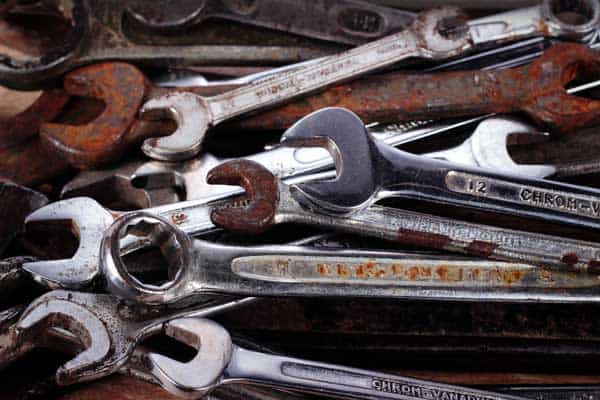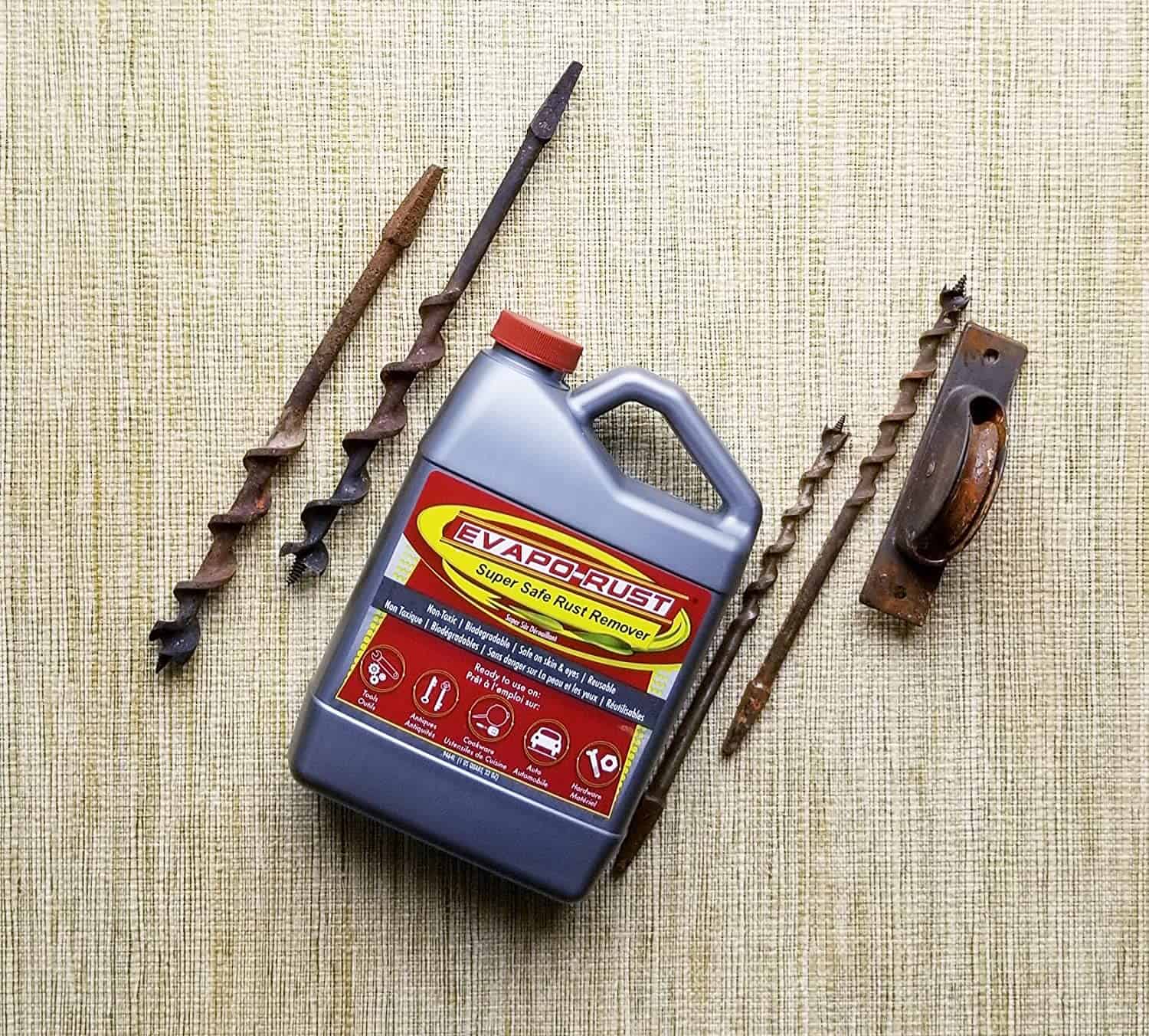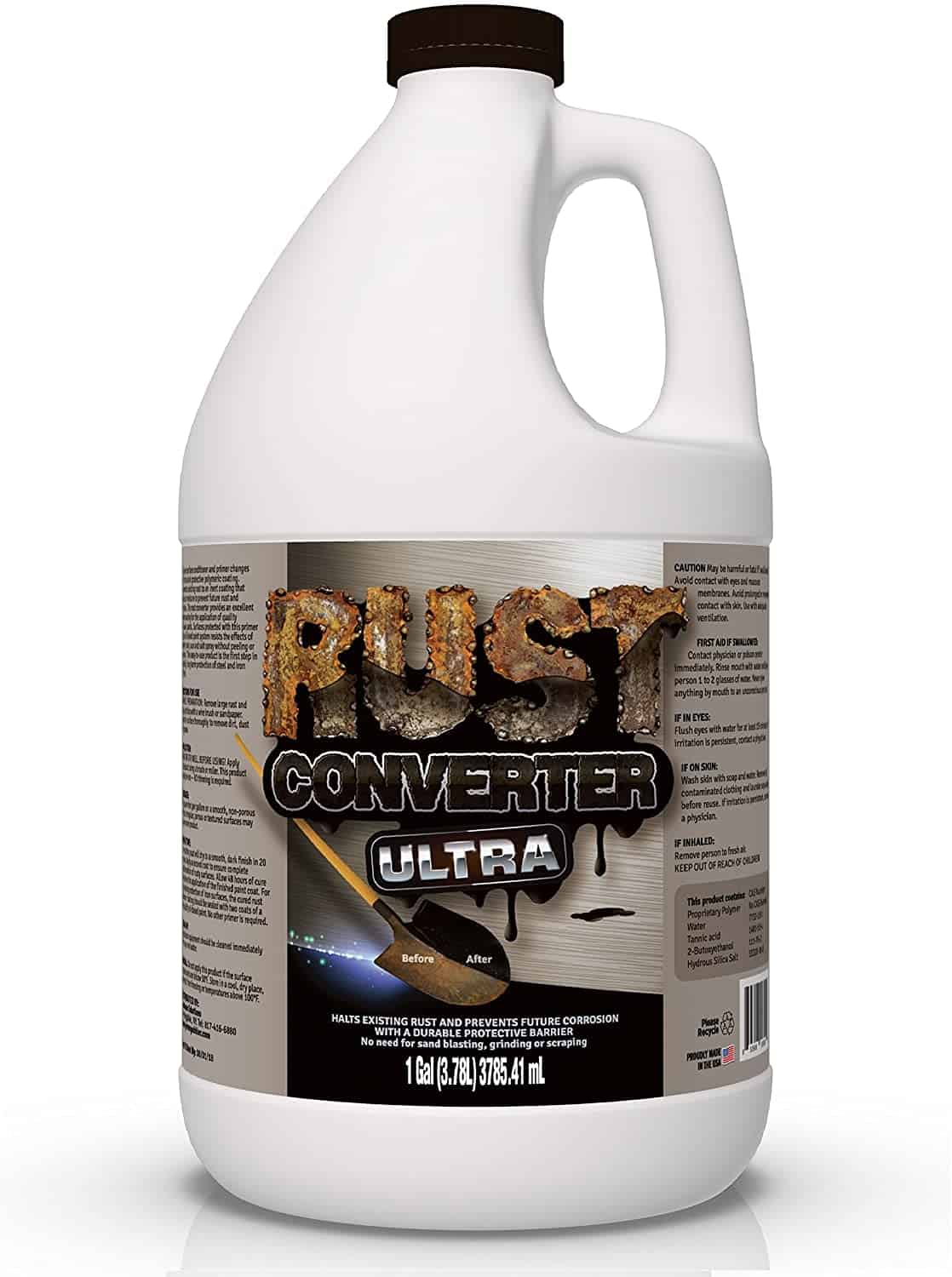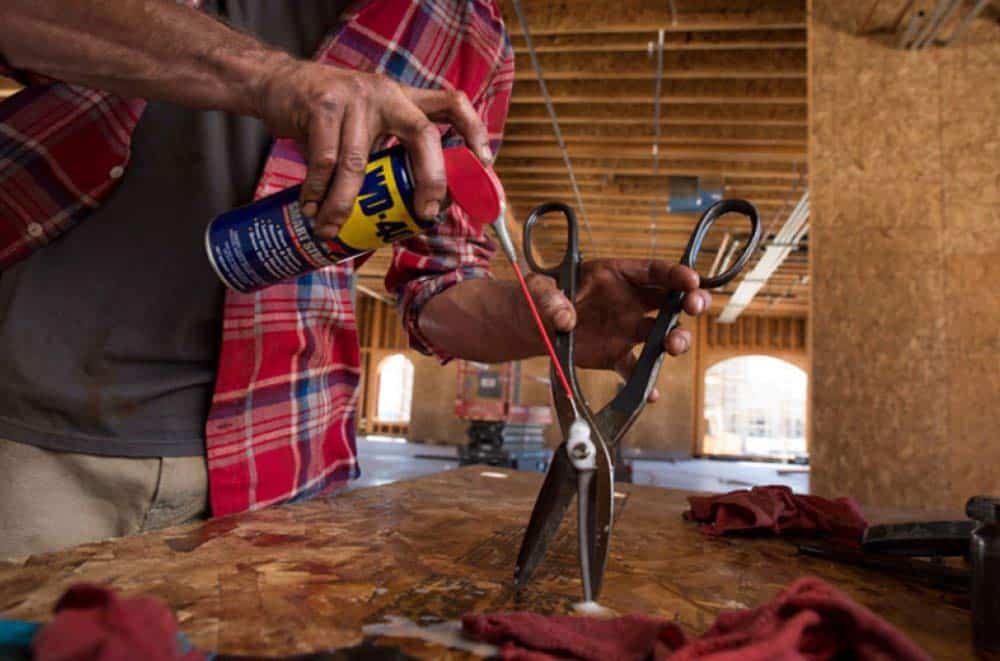Removing rust from tools is simple. You have to keep in mind that efficient rust removal requires your patience.
In the first section of this post, I will show you how to remove rust from tools using household items, and in the second section, I will guide you on how to do it using store-bought products.
We also have a related guide on the best garage door lubricant if you’re looking to prevent rust on your household items as well.

In this post we'll cover:
Method 1: Cleaning rust off tools Using Store-bought Products
Chemical Rust Remover Soak
There is a dazzling array of chemicals that you can buy and use to dissolve the rust. Usually, they’re manufactured using oxalic or phosphoric acid and can harm the skin.
That’s why you need to be very careful while using them. The best tip is to use gloves when handling chemical products.
Be sure to follow the product’s specific directions for use, as application procedures might differ among different products.
Most chemical removers need quite some time to set in and often require brushing afterward. Also, the products can be a little costly, and they usually work for small-scale rust removal.
A great non-toxic one is this Evapo-rust water-based one:

This is an excellent non-toxic rust remover for tools and car parts. You’ll be pleased to know this formula is gentle on the skin and doesn’t cause irritation.
It is a water-based product that removes rust without intense scrubbing. Also, the product is biodegradable and environmentally friendly.
It can be used on steel as well and it does not cause corrosion. Therefore, it is ideal to use on car parts, tools, and household items.
Rust Converters
Rather than removing the rust, converters work by reacting with the present rust and stopping further rusting.
They are like spray paints and function as a primer for a paint coat. For that reason, if you’re planning to paint over the tool, a rust converter is a great option.
The most highly rated brand is FDC, with their Rust Converter Ultra:

The rust converter ultra is a product designed to remove rust and protect items from future rusting. It is a highly efficient rust inhibitor solution that forms a protective barrier on metal.
This formula works to convert rust into a protective barrier. It is ultra-strong, so you can be sure it will get rid of large rust stains.
It’s easy to use the product, all you have to do is coat it with the solution, let it sit for a few minutes, then rub the rust off with a wire brush.
Abrasive Tools
This method will require lots of elbow grease; you will need to do quite some work with your hands. However, the technique is quite effective.
Abrasive tools include steel wool, which you likely find at the local store around the corner. If the tool is tremendous and the rust is widespread, an electric sander will be very helpful.
Start with the rougher grains, advancing to the more beautiful grains, to minimize damage to the tool.
Other metal tools, like screwdrivers, can help you scrape off the rust, but be sure to use fine-grain sandpaper once you’re done to get rid of scraping marks.
Citric Acid
Visit your local supermarket and get a small box of powdered citric acid.
Pour some of the acids into a plastic container and add some hot water, just enough to cover the tool your ridding of rust. Dip the tool into the mixture.
Watching the bubbles rising will be fun. Leave the tool in there overnight and rinse it with clean water in the morning.
Diesel
Purchase a liter of actual diesel (not fuel additives). Pour the diesel into a container and place the rusting tool in there. Let it sit there for around 24 hours.
Remove the tool and scrub it with a brass brush. Use a clean rag to wipe down the tool. Don’t forget to preserve the diesel for future use. You’ve got to put it in a can and cover it with a tight lid.
WD-40 rust loosener and protector

This spray solution is designed to loosen the bonds between your metal tool and the rust. It helps penetrate the porous layer of the rust. Since the product is a lubricant, the rust comes off easily.
Spray the rusted surface of the tool with WD-40 and let it sit for several minutes. Then, use a light abrasive cloth or brush to remove rust.
The advantage of using this product is that it offers rust protection so your tools don’t rust for a while.
Check the latest prices here on Amazon
Method 2: Clean rust off of Tools Using Household Ingredients
White vinegar
White vinegar reacts with the rust and dissolves it off the tool.
The reason that vinegar works so well as a rust remover is because the acetic acid of vinegar reacts and forms iron III acetate, a substance that is water-soluble.
So, vinegar actually removes the rust into the water but doesn’t clean the tool, so that’s why you need to brush or rub the rust off.
Just you need to do is soak the tool in white vinegar for several hours, and then brush the rusty paste off.
Is the tool too large to soak directly in the vinegar? Try pouring a layer of the vinegar over it and let it soak for a few hours.
Afterward, brush the tool and wipe it with a piece of cloth soaked in vinegar.
If the rust seems resilient and won’t come off easily, dip an aluminum foil in vinegar and use it to brush off the rust.
As well, you can use a metal brush or steel wool to remove the rust more easily.
How long do I soak metal in vinegar to remove rust?
In case you’re using regular vinegar, the process will still be viable, though it will take longer, maybe about 24 hours, to achieve the desired results.
The good thing is, after those 24 hours, you might not need to do much scrubbing to get rid of the rust.
Lime and salt
Generously coat the rusted area with salt and sprinkle some lime over the coat. Use as much time as you can obtain, and let the blend set in for around 2 hours before scrubbing it off.
I suggest using a rind from the lime to brush off the blend. That way, you’ll remove the rust efficiently without causing further damage to the metal. Feel free to use lemon in place of the lime.
Baking soda paste
Baking soda is the ultimate multifunctional ingredient. It is so easy to use and it scrubs off the rust from tools.
First, decrease the tools, clean them, and dry them well.
Then, add some baking soda to water and blend until you have a thick paste that can be spread over the metal.
Next, apply the paste to the rusty area of the tools. Let the paste set in before scrubbing off.
Use a brush to scrub off the paste carefully. You can use a toothbrush for smaller surfaces to scrub the paste off.
Finally, rinse the tool with clean water.
Potato and dish soap
Divide the potato into two halves and rub the cut end of one of the halves with some dish soap. Then, rub the potato against the metal and let it sit for a few hours.
The solvent, the potato, and the rust will react, making it easy to remove the rust. In case you don’t have dish soap, baking soda and water are an alternative.
Mix them with the potato and use the same procedure you’d have used with the dish soap to remove the rust.
Oxalic acid
You will need to be careful and take precautions while using this method. Get a pair of gloves, some protective clothing, and goggles. Don’t smoke or inhale gases from the acid directly.
The first step here is to wash the rusted tool with washing-up liquid, rinse it, and allow it to dry completely.
Next, mix five teaspoons of oxalic acid with around 300ml of warm water.
Soak the tool in the acid mix for approximately 20 minutes and afterward, scrub the rusted parts with a brass brush. Lastly, wash the tool with clean water and allow it to dry.
Lemon juice
The juice from lemon is very strong and powerful at removing rust quickly. What you need to do is rub your rusty tool with some salt.
Next, add lemon juice on top and let it sit for a few minutes. Don’t let the lemon juice sit on the tool for too long or it can cause damage.
This is a great natural rust remedy that leaves tools smelling like citrus. If you want to make the lemon juice even more potent, add some vinegar to the juice.
Coca Cola
Have you wondered if Coca Cola can remove rust? Yes, it can and the reason for that is that Coca Cola contains phosphoric acid.
This is a common ingredient in many rust cleaning products because it removes rust efficiently.
All you need to do is soak the rusty tools in cola for a few minutes and watch as the rust loosens and falls off the metal.
Coca Cola can be used to remove rust off all kinds of metallic objects, including nuts, bolts, battery terminals, and even utensils.
The only downside to this method is that it’s a sticky process and you need to cleanse the object well afterward.
Washing Soda and Ketchup
For this easy and affordable method of rust removal, all you have to do is make a mixture of water and washing soda. Put it in a spray bottle and spray your rusty tools all over with the mix.
Next, add a dose of ketchup to the rust spots. Let the ketchup and soda sit on the tool for approximately two hours.
Finally, rinse off with clean water and you’ll see your metal tool gleam.
Toothpaste
Everyone has toothpaste at home, so use this cheap product to remove rust from your tool.
Place toothpaste onto a piece of fabric and rub your tools, concentration on rusty patches. Let the paste sit on the metal for 10 minutes, then rinse off.
For best results, use a white consistent toothpaste, not the gel variety.
How do I keep my Stainless Steel tools clean?
Get sandpaper with fine grains and rub-down the tool in circular motions. Rub-down the sanded parts with sliced onion and finally rinse the stainless-steel tool with hot water.
Keep your tools dry
Do you know how rust works? It’s the result of a chemical reaction in which iron gets oxidized and starts flaking away.
Basically metals and alloys corrode and turn rusty in the presence of water and oxygen.
The surface of tools needs moisture to start rusting. Thus by keeping your tools dry, you minimize the chances of rusting.
Try storing your tools in a cool, dry place and dry them thoroughly each time they come into contact with water.
Apply a primer
Thinking of painting the tool? Apply a paint primer first to ensure the paint sticks. This will also prevent the metal from coming into direct contact with moisture.
If the tool’s surface is smooth, feel free to apply any spray-on primer. But, if the surface is rough, a filler primer is crucial for filling those little pits.
Paint a solid coat
Applying paint over a good primer will make it certain that no moisture reaches the metal. For the best results, go for the best quality of paint you can find.
Keep in mind that though spray paint is great for metal, painting with a brush helps the paint stick better. I recommend sealing the paint with a clear topcoat to minimize the oxidation rate.
What is the best way to restore a corroded hand tool?
One of the most common problems is that after several years, hand tools become so rusted, you can’t use them anymore.
Or, in some cases, you discover your dad’s old tools and you want to keep them but they look like heaps of rusty metal. Don’t fret because there is a solution.
I know that your first instinct is to throw the tool away. But, did you know you can restore the tool using vinegar?
Here is the easy way to restore rusty hand tools:
- Grab a large bucket and add at least 1 gallon or more of white vinegar. Do not dilute the vinegar, make sure you add just the vinegar.
- Place the tools in the bucket and cover them with a piece of plywood to ensure they stay submerged.
- Let the tools sit in the vinegar for approximately 4 hours.
- Now scrub the tools with steel wool and watch the rust dissolve away.
- If the tools are completely rusted, let them soak overnight or for 24 hours for the best results.
Conclusion
Feel free to combine some methods to remove rust. For instance, if you’re removing rust from pliers, allow it to soak in white vinegar for several hours, and then scrub it with steel wool.
While using chemical rust removers or converters, ensure you’re outside in a properly-ventilated place.
I'm Joost Nusselder, the founder of Tools Doctor, content marketer, and dad. I love trying out new equipment, and together with my team I've been creating in-depth blog articles since 2016 to help loyal readers with tools & crafting tips.
